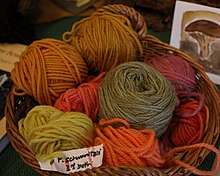


Mushrooms can be used to create color dyes via color-extraction with a solvent (often ammonia) as well as particulation of raw material.[1] The shingled hedgehog mushroom and related species contain blue-green pigments, which are used for dyeing wool in Norway.[2] The fruiting body of Hydnellum peckii can be used to produce a beige color when no mordant is used, and shades of blue or green depending on the mordant added.[3] Phaeolus schweinitzii produces green, yellow, gold, or brown colors, depending on the material dyed and the mordant used.[4]
| Mushroom | Color catalyst | Color created |
|---|---|---|
| Chanterelle | ammonia | dull yellow |
| Artist's conk | ammonia | rust |
| Horse mushroom | salt water | yellowish green |
| Meadow mushroom | salt water | yellowish green |
| Turkey tail | ammonia | variable |
| False turkey tail | ammonia | variable |
| Shaggy mane | iron pot/ammonia | greyish-green |
| King bolete | ammonia | reddish-yellow |
| Oyster mushroom | iron pot/ammonia | greyish-green |
| Lobster mushroom | ammonia | cinnamon pink to red |
| Dyer's polypore | ammonia copper pot/ammonia iron pot/ammonia salt water |
orange deep green rust red yellow (fluorescent under UV) |
| Maitake | ammonia | light yellow |
| Chicken of the woods | ammonia | orange |
| Giant puffball | ammonia | dark red |
| Lingzhi | ammonia | rust |
| Blewit | ammonia | green |
| Jumbo gym[5] | pH 4 | butter yellow |
| Western red dyer[5] | pH 7 to pH 7 | red, orange, pink, purple |
| Western jack o'lantern[5] | purple or green | |
| Dyer's puffball[5] | brown to orange |